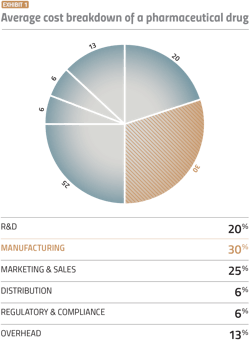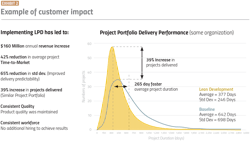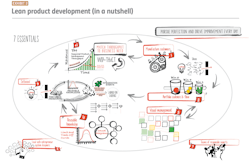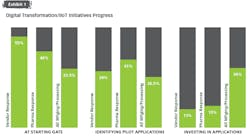In the dynamic realm of pharmaceuticals, where innovation intersects the challenges of rising drug costs, executives are presented with an opportune moment.
With recent policy changes, such as the executive order on lowering prescription drug costs which currently impacts Medicare and Medicaid, forward-thinking executives are rightfully contemplating the potential extension of these measures to all drugs. The question echoes: How can pharma leaders not only navigate these changes but proactively position their organizations for success?
Pharmaceutical executives now face a crossroads where the trajectory to success demands more than reaction; it requires anticipation. Executives are navigators of the future for their organizations. They must leverage insights into potential policy trajectories, aligning strategies with the evolving narrative of health care cost.
This is where the first to adopt proven lean innovation methods from other industries to their pharma organization create a distinct advantage. Navigating change is not merely a reaction to waves of transformation; it’s the proactive stance of a captain charting a course through uncharted waters.
Now is the time for leaders to challenge their organizations, not just for compliance but to retool for sustained success. It’s an acknowledgment that the pharma landscape is undergoing a metamorphosis, and those who anticipate and adapt will not just survive but thrive.
Charting a course
As executives respond to this pivotal moment, they aren’t just navigating change; they’re charting a course toward a future where their organizations stand as pillars of innovation, efficiency and societal impact. The journey begins with anticipation, strategizing, and a resolute commitment to the pharmaceutical future.
Compliance is not negotiable; it’s foundational. Yet, proactive compliance offers a strategic edge. Executives, poised at the helm, are pivotal in shaping robust compliance strategies that not only align with current policies but also position their organizations as trailblazers in an evolving regulatory landscape. This demands active engagement with policy developments, understanding their implications and reshaping organizational structures accordingly.
Navigating change transcends policy tweaks; it’s about charting a course and fostering a culture of continuous improvement. We must champion lean innovation practices not as a reaction but as a strategic choice, woven into the fabric of our organizations. This requires cultivating an environment where lean becomes intrinsic to how we operate.
Executives should view this transformation as a chance to optimize operations, fuel innovation and fortify organizations for lasting success. Embracing change isn’t just about survival; it’s about leading the charge in an industry poised for evolution.
In navigating change, proactive leadership is key. It demands foresight, strategic vision, and an understanding that compliance isn’t a destination — it’s an ongoing journey of adaptation and growth.
Lean’s business proposition
Consider this: the cost of a drug carries a substantial burden from the R&D process, constituting 10% to 30% of the total cost of the drug.
Compared to traditional products, pharmaceutical products carry a burden two to 10 times greater for R&D as a percentage of total product cost. By optimizing and enhancing the innovation process through lean innovation practices, a transformative change will occur. A mere doubling of R&D efficiency repeatedly demonstrated in other industries, for instance, translates to a remarkable 5% to 15% reduction in overall drug costs. This isn’t just a cost-saving measure; it’s a strategic move to safeguard profit margins. This is direct savings to the bottom line.
In the pharma industry, where decisions affect the health and well-being of countless individuals as well as the bottom line, the adoption of lean innovation isn’t just a business strategy; it’s a transformative proposition. For pharma executives, this goes beyond the realm of cost reduction — it’s about fortifying organizations for a future where efficiency, profitability and societal impact converge in the face of increasing pressures for reduced drug costs.
Beyond the immediate cost benefits, the beauty of lean innovation lies in its capacity to unlock valuable R&D resources. By improving efficiency, pharma companies not only save costs but free up additional R&D capacity. This liberated surplus resource should not be idle; it can be redirected towards developing new products. The ripple effect is an engine that powers a diversified product portfolio, generating additional revenue streams, and, importantly, boosting revenue and profits while delivering greater good to humanity.
R&D improvement is the gift that keeps giving with benefits that also include:
Enhanced agility in innovation
Not only does lean innovation reduce time-to-market, but as an outcome of being faster, it also introduces an element of agility into the traditionally rigorous and sequential drug development process.
Executives can steer their organizations towards a more responsive and adaptive approach, ensuring that they stay ahead in a rapidly evolving industry. Being nimble is not just about the speed of product development; it’s to emerging health care needs and staying competitive in a dynamic market.
Mitigating risk and increasing predictability
The lean development advantage extends well beyond cost reduction — it’s about mitigating risks inherent in drug development. By embracing an iterative learning processes and set-based experimentation, executives enhance the predictability of outcomes.
Identifying potential issues earlier in the development process reduces the likelihood of late-stage failures, ultimately lowering the financial risks associated with bringing a new drug to market and over time, the cost incurred from these dead ends.
Strategic positioning from changing regulations
In a landscape where drug pricing regulations are evolving, the lean advantage strategically positions pharma companies to excel. The ability to showcase proactive measures
towards efficiency and cost-effectiveness aligns seamlessly with the broader industry narrative. Pharma executives embracing lean methodologies aren’t just responding to change; they’re shaping a narrative of resilience and adaptability that resonates with regulators and stakeholders alike.
The lean advantage isn’t just about achieving more with less; it’s about adopting new strategies to position pharma companies for long-term success. For executives, this means more than immediate cost savings, as it’s a pathway to transforming their organizations into agile, innovative and resilient entities that can thrive amidst industry evolution.
Securing future success
The pharma industry is at a pivotal moment, navigating regulatory changes, evolving policies, and the need for innovation. For executives, it’s not just about reacting to changes — it’s about forging a strategic vision that positions their organizations for enduring success. The impact on the R&D portfolio can be dramatic for a company that implements a lean development methodology approach (Exhibit 2).
The adoption of lean development methods isn’t merely a tactical response to policy changes; it’s a strategic vision to secure the future success of pharma companies (Exhibit 3). As the industry faces the possibility of broader cost reduction measures, those who proactively embrace lean innovation gain a dual advantage: compliance with evolving regulations and a fortified business model that is inherently more efficient and resilient.
Adopting lean development methods is a proactive assertion of leadership and forward-thinking, instead of a mere reaction to external pressures. As demonstrated previously in the adoption of lean methods in manufacturing, a lean development approach puts organizations ahead of the curve and drives increased innovation, while ensuring efficient resource utilization to deliver maximum value to customers.
Pharma executives are presented with an unprecedented opportunity — to not only navigate policy changes but to proactively shape their organizations for a future where efficiency, profitability and societal impact converge. The initiative to lower drug costs for Americans serves as a resounding call to action — an action emphasizing the potential for transformative change that extends beyond compliance, offering strategic advantages. In embracing this proactive approach, all stakeholders stand to gain.








